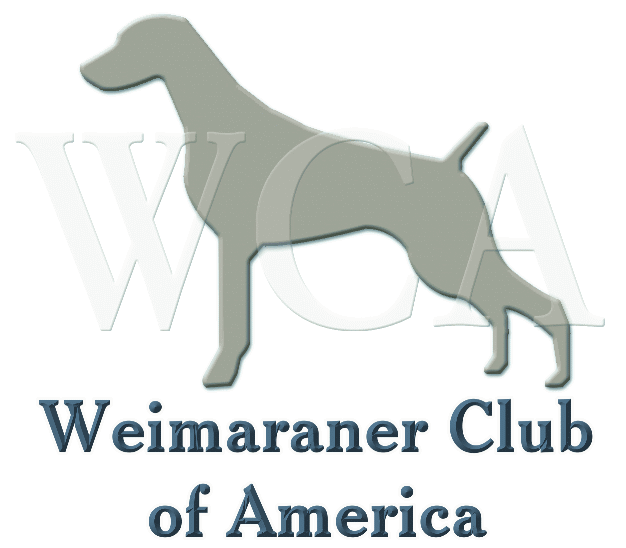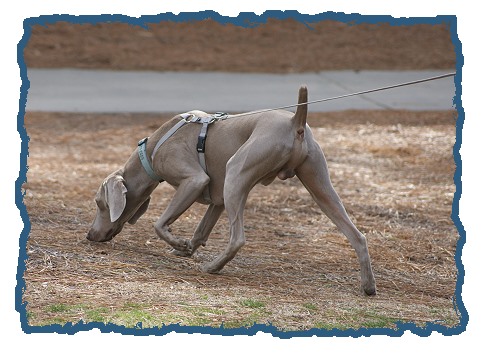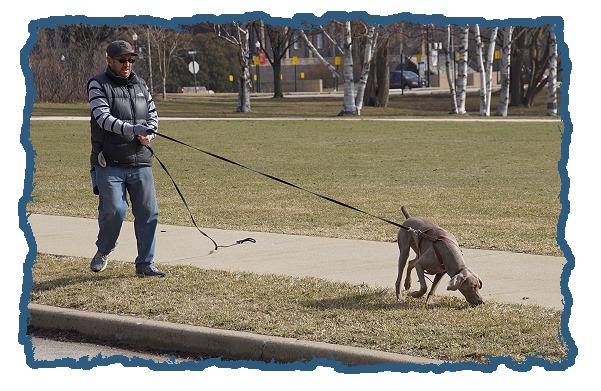
What is Tracking?
![]() Dogs have a very keen sense of smell – 100,000 times stronger than humans! Dogs with the help of their noses are often used to find lost people and animals, drugs, avalanche and disaster victims, and even to detect cancer! AKC Tracking is a canine sport that demonstrates a dog’s natural ability to recognize and follow a scent and is the foundation of canine search and rescue work. Unlike obedience and rally trials, where dogs respond to the handler’s commands, in tracking the dog is completely in charge, for only he knows how to use his nose to find and follow the track. For many, the greatest pleasure of tracking is the hours spent outside training and interacting with their dogs. The tracking community is known for its camaraderie and they all share in the excitement of a “pass” and the disappointment of a “fail.”
Dogs have a very keen sense of smell – 100,000 times stronger than humans! Dogs with the help of their noses are often used to find lost people and animals, drugs, avalanche and disaster victims, and even to detect cancer! AKC Tracking is a canine sport that demonstrates a dog’s natural ability to recognize and follow a scent and is the foundation of canine search and rescue work. Unlike obedience and rally trials, where dogs respond to the handler’s commands, in tracking the dog is completely in charge, for only he knows how to use his nose to find and follow the track. For many, the greatest pleasure of tracking is the hours spent outside training and interacting with their dogs. The tracking community is known for its camaraderie and they all share in the excitement of a “pass” and the disappointment of a “fail.”
How Do I Get Started in Tracking?
![]() Getting started in tracking is easy and you won’t find a more willing participant than your dog! A puppy instinctively uses his nose – training your dog to track simply hones his natural ability. And since all dogs have a natural ability to follow a scent, any breed is capable of learning to track. Your first step is finding a tracking class or an instructor who is experienced in the sport. Some AKC–affiliated clubs offer tracking classes and some are “Tracking Only” clubs. To find a club in your area, go to the AKC website, Club Search or Training Resources. Tracking requires very little equipment. You just need a harness, a 20–to–40 foot lead, a few flags to mark your track, and an open grassy area free of obstacles such as roads, ditches or woods. Before you enter a Tracking Dog Test (TD), you must have the dog certified by an AKC–approved or provisional judge. This certification form must accompany the entry form. Once you and your dog are ready, find a tracking event in your area by going to the AKC Events Calendar on the AKC website. There is a great demand for tracking tests and the number of dogs that can be judged in one day is very limited. As a result, there are more entries than spaces available. For this reason tracking is not open to dogs listed in AKC Canine Partners at this time.
Getting started in tracking is easy and you won’t find a more willing participant than your dog! A puppy instinctively uses his nose – training your dog to track simply hones his natural ability. And since all dogs have a natural ability to follow a scent, any breed is capable of learning to track. Your first step is finding a tracking class or an instructor who is experienced in the sport. Some AKC–affiliated clubs offer tracking classes and some are “Tracking Only” clubs. To find a club in your area, go to the AKC website, Club Search or Training Resources. Tracking requires very little equipment. You just need a harness, a 20–to–40 foot lead, a few flags to mark your track, and an open grassy area free of obstacles such as roads, ditches or woods. Before you enter a Tracking Dog Test (TD), you must have the dog certified by an AKC–approved or provisional judge. This certification form must accompany the entry form. Once you and your dog are ready, find a tracking event in your area by going to the AKC Events Calendar on the AKC website. There is a great demand for tracking tests and the number of dogs that can be judged in one day is very limited. As a result, there are more entries than spaces available. For this reason tracking is not open to dogs listed in AKC Canine Partners at this time.
Tracking Titles
![]() A dog can earn three AKC Tracking titles, each with an increased degree of difficulty. The TD (Tracking Dog) title must be earned before competing for a TDX (Tracking Dog Excellent) or VST (Variable Surface Tracker) title. A Champion Tracker (CT) is awarded only to those dogs that have earned all three tracking titles – TD, TDX and VST. If a dog is awarded the CT title, he is among the elite of those active in tracking. To earn a tracking title, a dog needs to pass the test in which he is exhibiting only once.
A dog can earn three AKC Tracking titles, each with an increased degree of difficulty. The TD (Tracking Dog) title must be earned before competing for a TDX (Tracking Dog Excellent) or VST (Variable Surface Tracker) title. A Champion Tracker (CT) is awarded only to those dogs that have earned all three tracking titles – TD, TDX and VST. If a dog is awarded the CT title, he is among the elite of those active in tracking. To earn a tracking title, a dog needs to pass the test in which he is exhibiting only once.
Tracking Dog (TD)
The TD track is from 440–to–500 yards long with 3–to–5 turns (or change in direction), and aged from a half–hour to two hours. A dog must indicate a glove or wallet placed at the end of the track. Tracks are plotted in an open field with uniform cover. There are no obstacles. The start of the track will be marked with a flag. A second flag is placed 30 yards from the start flag to indicate the direction of the first leg of the track. There are no other flags in the field.
Tracking Dog Excellent (TDX)
The TDX track is 800–to–1000 yards long with 5–to–7 turns, and aged from 3–to–5 hours. The track also has two sets of cross (diversionary) tracks and has some of the aforementioned obstacles. The start is marked with a single flag and the dog must determine the direction of the first leg. There are four dissimilar articles for each track, one at the start and three more on the track.
![]()
Variable Surface Tracking (VST)
A VST track is from 600–to–800 yards long, with 4–to–8 turns, and aged from 3–to–5 hours. The articles must be one each of leather, cloth, plastic and metal. The VST track must also contain three different surfaces with one turn on a non–vegetated surface such as concrete. This test demonstrates the utility of the tracking dog to work in an urban environment.
How a Tracking Test Works
For the host club and the two judges, a tracking test is a two–day commitment, regardless of weather. Tracking tests are usually held on Sunday, but the judges and tracklayers spend most of Saturday plotting a track for each dog. The judges draw charts of each track indicating landmarks that will allow them to locate the track with flags that mark the turns. The flags will be removed when the tracklayers walk the track the morning of the test. On the morning of the test, the exhibitors gather for a “draw,” which determines the order dogs are to exhibit. After the tracks have aged the required time, the exhibitor puts the harness on the dog, attaches a 20–to–40–foot lead and begins the track. The dog is not allowed off lead at any time. The dog must follow the path the tracklayer has walked and find the article(s) dropped along the track. Judges follow the dog and handler to determine if the dog is on or off the track. If the dog is off the track and the judges determine the dog cannot return, one judge will blow the whistle signaling the dog has failed. There is no time limit as long as the dog is working. If the dog follows the track and finds the article(s) placed on the track, he earns the tracking title for the level at which he is exhibiting.
Reprinted from the AKC website. For additional information see http://www.akc.org/pdfs/events/GOCET1.pdf
Download "Tracking Training"


Video of a Tracking Demonstration
